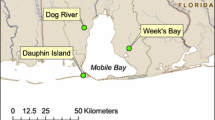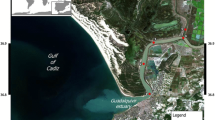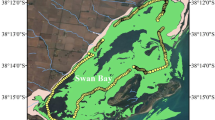Abstract
Currently, there is a lack of knowledge about GHG emissions, specifically N2O and CH4, in subtropical coastal freshwater wetland and mangroves in the southern hemisphere. In this study, we quantified the gas fluxes and substrate availability in a subtropical coastal wetland off the coast of southeast Queensland, Australia over a complete wet-dry seasonal cycle. Sites were selected along a salinity gradient ranging from marine (34 psu) in a mangrove forest to freshwater (0.05 psu) wetland, encompassing the range of tidal influence. Fluxes were quantified for CH4 (range −0.4–483 mg C–CH4 h−1 m−2) and N2O (−5.5–126.4 μg N–N2O h−1 m−2), with the system acting as an overall source for CH4 and N2O (mean N2O and CH4 fluxes: 52.8 μg N–N2O h−1 m−2 and 48.7 mg C–CH4 h−1 m−2, respectively). Significantly higher N2O fluxes were measured during the summer months (summer mean 64.2 ± 22.2 μg N–N2O h−1 m−2; winter mean 33.1 ± 24.4 µg N–N2O h–1 m−2) but not CH4 fluxes (summer mean 30.2 ± 81.1 mg C–CH4 h−1 m−2; winter mean 37.4 ± 79.6 mg C–CH4 h−1 m−2). The changes with season are primarily driven by temperature and precipitation controls on the dissolved inorganic nitrogen (DIN) concentration. A significant spatial pattern was observed based on location within the study site, with highest fluxes observed in the freshwater tidal wetland and decreasing through the mangrove forest. The dissolved organic carbon (DOC) varied throughout the landscape and was correlated with higher CH4 fluxes, but this was a nonlinear trend. DIN availability was dominated by N–NH4 and correlated to changes in N2O fluxes throughout the landscape. Overall, we did not observe linear relationships between CH4 and N2O fluxes and salinity, oxygen or substrate availability along the fresh-marine continuum, suggesting that this ecosystem is a mosaic of processes and responses to environmental changes.





Similar content being viewed by others
References
Aelion CM, Engle MR (2010) Evidence for acclimation of N cycling to episodic N inputs in anthropogenically-affected intertidal salt marsh sediments. Soil Biol Biochem 42:1006–1008. doi:10.1016/j.soilbio.2010.02.015
Allen DE, Dalal RC, Rennenberg H, Meyer RL, Reeves S, Schmidt S (2007) Spatial and temporal variation of nitrous oxide and methane flux between subtropical mangrove sediments and the atmosphere. Soil Biol Biochem 39:622–631. doi:10.1016/j.soilbio.2006.09.013
Allen D, Dalal RC, Rennenberg H, Schmidt S (2011) Seasonal variation in nitrous oxide and methane emissions from subtropical estuary and coastal mangrove sediments. Aust Plant Biol 13:126–133. doi:10.1111/j.1438-8677.2010.00331.x
Alongi DM (1996) The dynamics of benthic nutrient pools and fluxes in tropical mangrove forests. J Mar Res 54:123–148. doi:10.1357/0022240963213475
Alongi DM (2002) Present state and future of the world’s mangrove forests. Environ Conserv 29:331–349. doi:10.1017/s0376892902000231
Alongi DM (2012) Carbon sequestration in mangrove forests. Carbon Manag 3:313–322. doi:10.4155/cmt.12.20
Alongi DM, Brinkman R (2011) Hydrology and Biogeochemistry of Mangrove Forests. In: Levia DF, CarlyleMoses D, Tanaka T (eds) Forest Hydrology and Biogeochemistry: Synthesis of Past Research and Future Directions, vol 216. Ecological Studies-Analysis and Synthesis. pp 203-219. doi:10.1007/978-94-007-1363-5_10
Alongi DM et al (2001) Organic carbon accumulation and metabolic pathways in sediments of mangrove forests in southern Thailand. Mar Geol 179:85–103. doi:10.1016/s0025-3227(01)00195-5
Banks EW, Brunner P, Simmons CT (2011) Vegetation controls on variably saturated processes between surface water and groundwater and their impact on the state of connection. Water Resour Res 47:W11517
Barendregt A, Swarth CW (2013) Tidal freshwater wetlands: variation and changes. Estuar Coasts 36:445–456. doi:10.1007/s12237-013-9626-z
Bartlett KB, Bartlett DS, Harriss RC, Sebacher DI (1987) Methane emissions along a salt-marsh salinity gradient. Biogeochemistry 4:183–202. doi:10.1007/bf02187365
Baulch HM, Schiff SL, Maranger R, Dillon PJ (2011) Nitrogen enrichment and the emission of nitrous oxide from streams. Glob Biogeochem Cycles. doi:10.1029/2011gb004047
Bergamaschi BA, Krabbenhoft DP, Aiken GR, Patino E, Rumbold DG, Orem WH (2012) Tidally driven export of dissolved organic carbon, total mercury, and methylmercury from a mangrove-dominated estuary. Environ Sci Technol 46:1371–1378. doi:10.1021/es2029137
Bouillon S et al (2008) Mangrove production and carbon sinks: a revision of global budget estimates. Glob Biogeochem Cycles. doi:10.1029/2007gb003052
Burgin AJ, Groffman PM (2012) Soil O2 controls denitrification rates and N2O yield in a riparian wetland. J Geophys Res-Biogeosci. doi:10.1029/2011jg001799
Bye JAT, Narayan KA (2009) Groundwater response to the tide in wetlands: observations from the Gillman Marshes, South Australia. Estuar Coast Shelf Sci 84:219–226. doi:10.1016/j.ecss.2009.06.025
Cabezas A, Gonzalez E, Gallardo B, Garcia M, Gonzalez M, Comin F (2008) Effects of hydrological connectivity on the substrate and understory structure of riparian wetlands in the Middle Ebro River (NE Spain): implications for restoration and management. Aquat Sci 70:361–376. doi:10.1007/s00027-008-8059-4
Cabezas A, Comin FA, Walling DE (2009) Changing patterns of organic carbon and nitrogen accretion on the middle Ebro floodplain (NE Spain). Ecol Eng 35:1547–1558. doi:10.1016/j.ecoleng.2009.07.006
Chapuis-Lardy L, Wrage N, Metay A, Chotte JL, Bernoux M (2007) Soils, a sink for N2O? A review. Glob Change Biol 13:1–17. doi:10.1111/j.1365-2486.2006.01280.x
Chen GC, Tam NFY, Ye Y (2012) Spatial and seasonal variations of atmospheric N2O and CO2 fluxes from a subtropical mangrove swamp and their relationships with soil characteristics. Soil Biol Biochem 48:175–181. doi:10.1016/j.soilbio.2012.01.029
Cheng XL et al (2007) CH(4) and N(2)O emissions from Spartina alterniflora and Phragmites australis in experimental mesocosms. Chemosphere 68:420–427. doi:10.1016/j.chemosphere.2007.01.004
Chiu CY, Lee SC, Chen TH, Tian GL (2004) Denitrification associated N loss in mangrove soil. Nutr Cycl Agroecosyst 69:185–189. doi:10.1023/b:fres.0000035170.46218.92
Clough TJ, Addy K, Kellogg DQ, Nowicki BL, Gold AJ, Groffman PM (2007) Dynamics of nitrous oxide in groundwater at the aquatic-terrestrial interface. Glob Change Biol 13:1528–1537. doi:10.1111/j.1365-2486.2007.01361.x
Conrad R (1996) Soil microorganisms as controllers of atmospheric trace gases (H2, CO, CH4, OCS, N2O, and NO). Microbiol Rev 60:609–640
Cox M, James A, Hawke A, Specht A, Raiber M, Taulis M (2011) North Stradbroke Island 3D hydrology: Surface water features, settings and groundwater links. Proc R Soc Qld 117:47–64
Cuhel J, Simek M, Laughlin RJ, Bru D, Cheneby D, Watson CJ, Philippot L (2010) Insights into the effect of soil pH on N2O and N-2 emissions and denitrifier community size and activity. Appl Environ Microbiol 76:1870–1878. doi:10.1128/aem.02484-09
Dalal RC, Allen DE (2008) Greenhouse gas fluxes from natural ecosystems. Aust J Bot 56:369–407. doi:10.1071/bt07128
Davidson E, Kingerlee W (1997) A global inventory of nitric oxide emissions from soils. Nutr Cycl Agroecosyst 48:37–50. doi:10.1023/A:1009738715891
Feller IC, Lovelock CE, Berger U, McKee KL, Joye SB, Ball MC (2010) Biocomplexity in mangrove ecosystems. Annu Rev Mar Sci 2:395–417. doi:10.1146/annurev.marine.010908.163809
Fernandes SO, Bharathi PAL (2011) Nitrate levels modulate denitrification activity in tropical mangrove sediments (Goa, India). Environ Monit Assess 173:117–125. doi:10.1007/s10661-010-1375-x
Fernandes SO, Bharathi PAL, Bonin PC, Michotey VD (2010) Denitrification: an important pathway for nitrous oxide production in tropical mangrove sediments (Goa, India). J Environ Qual 39:1507–1516. doi:10.2134/jeq2009.0477
Ferron S, Ortega T, Gomez-Parra A, Forja JM (2007) Seasonal study of dissolved CH4CO2 and N2O in a shallow tidal system of the bay of Cadiz (SW Spain). J Mar Syst 66:244–257. doi:10.1016/j.jmarsys.2006.03.021
Fiedler S, Sommer M (2000) Methane emissions, groundwater levels and redox potentials of common wetland soils in a temperate-humid climate. Glob Biogeochem Cycles 14:1081–1093. doi:10.1029/1999GB001255
Finkl CW, Charlier RH (2003) Sustainability of subtropical coastal zones in southeastern Florida: challenges for urbanized coastal environments threatened by development, pollution, water supply, and storm hazards. J Coast Res 19:934–943
Fromin N, Pinay G, Montuelle B, Landais D, Ourcival JM, Joffre R, Lensi R (2010) Impact of seasonal sediment desiccation and rewetting on microbial processes involved in greenhouse gas emissions. Ecohydrology 3:339–348. doi:10.1002/eco.115
Galloway JN, Cowling EB (2002) Reactive nitrogen and the world: 200 years of change. Ambio 31:64–71. doi:10.1639/0044-7447(2002)031[0064:rnatwy]2.0.co;2
García-Ruiz R, Pattinson SN, Whitton BA (1998) Denitrification in river sediments: relationship between process rate and properties of water and sediment. Freshw Biol 39:467–476
Groffman PM, Gold AJ, Addy K (2000) Nitrous oxide production in riparian zones and its importance to national emission inventories. Chemosph Glob Change Sci 2:291–299
Groffman P et al (2009) Challenges to incorporating spatially and temporally explicit phenomena (hotspots and hot moments) in denitrification models. Biogeochemistry 93:49–77
Hamilton SK (2010) Biogeochemical implications of climate change for tropical rivers and floodplains. Hydrobiologia 657:19–35. doi:10.1007/s10750-009-0086-1
Hernandez ME, Mitsch WJ (2007) Denitrification in created riverine wetlands: influence of hydrology and season. Ecol Eng 30:78–88
Jahangir MMR et al (2012) Denitrification potential in subsoils: a mechanism to reduce nitrate leaching to groundwater. Agric Ecosyst Environ 147:13–23. doi:10.1016/j.agee.2011.04.015
Jahangir MMR et al (2013) Denitrification and indirect N2O emissions in groundwater: hydrologic and biogeochemical influences. J Contam Hydrol 152:70–81. doi:10.1016/j.jconhyd.2013.06.007
Jauhiainen J, Takahashi H, Heikkinen JEP, Martikainen PJ, Vasander H (2005) Carbon fluxes from a tropical peat swamp forest floor. Glob Change Biol 11:1788–1797. doi:10.1111/j.1365-2486.2005.001031.x
Jennerjahn TC (2012) Biogeochemical response of tropical coastal systems to present and past environmental change. Earth Sci Rev 114:19–41. doi:10.1016/j.earscirev.2012.04.005
Kettunen A (2003) Connecting methane fluxes to vegetation cover and water table fluctuations at microsite level: a modeling study. Glob Biogeochem Cycles 17:1051–1070
Kettunen A, Kaitala V, Lehtinen A, Lohila A, Alm J, Silvola J, Martikainen PJ (1999) Methane production and oxidation potentials in relation to water table fluctuations in two boreal mires. Soil Biol Biochem 31:1741–1749
Kim DG, Giltrap D, Hernandez-Ramirez G (2013) Background nitrous oxide emissions in agricultural and natural lands: a meta-analysis. Plant Soil 373:17–30. doi:10.1007/s11104-013-1762-5
Kingston HM, Walter PJ (2007) Test methods for evaluating solid waste, physical/chemical methods United States Environmental Protection Agency; office of solid waste; economic, methods, and risk analysis division
Kolb S, Horn MA (2012) Microbial CH(4) and N(2)O consumption in acidic wetlands. Front Microbiol 3:78. doi:10.3389/fmicb.2012.00078
Kort EA et al (2011) Tropospheric distribution and variability of N2O: evidence for strong tropical emissions. Geophys Res Lett 38:5. doi:10.1029/2011gl047612
Kreuzwieser J, Buchholz J, Rennenberg H (2003) Emission of methane and nitrous oxide by Australian mangrove ecosystems. Plant Biol 5:423–431. doi:10.1055/s-2003-42712
Leach L (2011) Hydrology and physical setting of North Stradbroke Island. Proc R Soc Qld 117:21–46
Lee R, Porubsky W, Feller I, McKee K, Joye S (2008) Porewater biogeochemistry and soil metabolism in dwarf red mangrove habitats (Twin Cays, Belize). Biogeochemistry 87:181–198. doi:10.1007/s10533-008-9176-9
Liengaard L, Nielsen LP, Revsbech NP, Priem A, Elberling B, Enrich-Prast A, Kuhl M (2013) Extreme emission of N2O from tropical wetland soil (Pantanal, South America). Front Microbiol. doi:10.3389/fmicb.2012.00433
Livesley SJ, Andrusiak SM (2012) Temperate mangrove and salt marsh sediments are a small methane and nitrous oxide source but important carbon store. Estuar Coast Shelf Sci 97:19–27. http://dx.doi.org/mur
Loheide SP, Booth EG (2011) Effects of changing channel morphology on vegetation, groundwater, and soil moisture regimes in groundwater-dependent ecosystems. Geomorphology 126:364–376. doi:10.1016/j.geomorph.2010.04.016
Maher D, Eyre B (2011) Benthic carbon metabolism in southeast Australian estuaries: habitat importance, driving forces, and application of artificial neural network models. Mar Ecol Prog Ser 439:97–115. doi:10.3354/meps09336
Masselink G, Gehrels R (2015) Introduction to Coastal Environments and Global Change. In: Coastal Environments and Global Change. Wiley, pp 1–27
McClain ME et al (2003) Biogeochemical hot spots and hot moments at the interface of terrestrial and aquatic ecosystems. Ecosystems 6:301–312
Meyer RL, Allen DE, Schmidt S (2008) Nitrification and denitrification as sources of sediment nitrous oxide production: a microsensor approach. Mar Chem 110:68–76. doi:10.1016/j.marchem.2008.02.004
Munoz-Hincapie M, Morell JM, Corredor JE (2002) Increase of nitrous oxide flux to the atmosphere upon nitrogen addition to red mangroves sediments. Mar Pollut Bull 44:992–996. doi:10.1016/s0025-326x(02)00132-7
Murray RH, Erler DV, Eyre BD (2015) Nitrous oxide fluxes in estuarine environments: response to global change. Glob Change Biol 21:3219–3245. doi:10.1111/gcb.12923
Nahlik AM, Mitsch WJ (2011) Methane emissions from tropical freshwater wetlands located in different climatic zones of Costa Rica. Glob Change Biol 17:1321–1334. doi:10.1111/j.1365-2486.2010.02190.x
Neubauer SC, Franklin RB, Berrier DJ (2013) Saltwater intrusion into tidal freshwater marshes alters the biogeochemical processing of organic carbon. Biogeosciences 10:8171–8183. doi:10.5194/bg-10-8171-2013
Nykanen H, Alm J, Lang K, Silvola J, Martikainen PJ (1995) Emissions of CH4, N2O and CO2 from a virgin fen and a fen drained for grassland in Finland. J Biogeogr 22:351–357. doi:10.2307/2845930
Odum WE (1988) Comparative ecology of tidal fresh-water and salt marshes. Annu Rev Ecol Syst 19:147–176. doi:10.1146/annurev.es.19.110188.001051
Page KL, Dalal RC (2011) Contribution of natural and drained wetland systems to carbon stocks, CO2, N2O, and CH4 fluxes: an Australian perspective. Soil Res 49:377–388. doi:10.1071/sr11024
Pina-Ochoa E, Alvarez-Cobelas M (2006) Denitrification in aquatic environments: a cross-system analysis. Biogeochemistry 81:111–130
Poffenbarger HJ, Needelman BA, Megonigal JP (2011) Salinity influence on methane emissions from tidal marshes. Wetlands 31:831–842. doi:10.1007/s13157-011-0197-0
Queensland (2014) Resources, WetlandInfo
Rajkumar AN, Barnes J, Ramesh R, Purvaja R, Upstill-Goddard RC (2008) Methane and nitrous oxide fluxes in the polluted Adyar River and estuary, SE India. Mar Pollut Bull 56:2043–2051. doi:10.1016/j.marpolbul.2008.08.005
Rayment GE, Lyons DJ (2011) Soil chemical methods—Australasia. Australian soil and land survey handbooks series. CSIRO Publishing
Reddy KR, DeLaune RD (2008) Biogeochemistry of wetlands: science and applications. CRC Press, Boca Raton
Saha AK, Sternberg LDO, Ross MS, Miralles-Wilhelm F (2010) Water source utilization and foliar nutrient status differs between upland and flooded plant communities in wetland tree islands. Wetl Ecol Manag 18:343–355. doi:10.1007/s11273-010-9175-1
Seitzinger SP, Kroeze C, Styles RV (2000) Global distribution of N2O emissions from aquatic systems: natural emissions and anthropogenic effects. Chemosph Glob Change Sci 2:267–279
Specht R (2011) Plant communities of North Stradbroke Island: development of structure and species richness. Proc R Soc Qld 117:181–191
Statham PJ (2012) Nutrients in estuaries—An overview and the potential impacts of climate change. Sci Total Environ 434:213–227. doi:10.1016/j.scitotenv.2011.09.088
Stephens KM (2009) The flora of North Stradbroke Island. The State of Queensland, Environmental Protection Agency, Brisbane
Terry RE, Tate RL III, Duxbury JM (1981) The effect of flooding on nitrous oxide emissions from an organic soil. Soil Sci 132:228–232
Tong C, Huang JF, Hu ZQ, Jin YF (2013) Diurnal variations of carbon dioxide, methane, and nitrous oxide vertical fluxes in a subtropical estuarine marsh on neap and spring tide days. Estuar Coasts 36:633–642. doi:10.1007/s12237-013-9596-1
van Dijk G, Smolders AJP, Loeb R, Bout A, Roelofs JGM, Lamers LPM (2015) Salinization of coastal freshwater wetlands; effects of constant versus fluctuating salinity on sediment biogeochemistry. Biogeochemistry 126:71–84. doi:10.1007/s10533-015-0140-1
Verhoeven JTA, Arheimer B, Yin CQ, Hefting MM (2006) Regional and global concerns over wetlands and water quality. Trends Ecol Evolut 21:96–103
Vicca S, Janssens IA, Flessa H, Fiedler S, Jungkunst HF (2009) Temperature dependence of greenhouse gas emissions from three hydromorphic soils at different groundwater levels. Geobiology 7:465–476. doi:10.1111/j.1472-4669.2009.00205.x
Vidon P et al (2010) Hot spots and hot moments in Riparian zones: potential for improved water quality management. J Am Water Res Assoc 46:278–298. doi:10.1111/j.1752-1688.2010.00420.x
Wallenstein MD, Myrold DD, Firestone M, Voytek M (2006) Environmental controls on denitrifying communities and denitrification rates: insights from molecular methods. Ecol Appl 16:2143–2152
Wang DQ et al (2007) Summer-time denitrification and nitrous oxide exchange in the intertidal zone of the Yangtze Estuary. Estuar Coast Shelf Sci 73:43–53. doi:10.1016/j.ecss.2006.11.002
Weier KL, Doran JW, Power JF, Walters DT (1993) Denitrification and the dinitrogen/nitrous oxide ratio as affected by soil water, available carbon, and nitrate. Soil Sci Soc Am J 57:66–72. doi:10.2136/sssaj1993.03615995005700010013x
Weston NB, Neubauer SC, Velinsky DJ, Vile MA (2014) Net ecosystem carbon exchange and the greenhouse gas balance of tidal marshes along an estuarine salinity gradient. Biogeochemistry 120:163–189. doi:10.1007/s10533-014-9989-7
Wetzel PR et al (2011) Biogeochemical processes on tree islands in the greater everglades: initiating a new paradigm. Crit Rev Environ Sci Technol 41:670–701. doi:10.1080/10643389.2010.530908
Weymann D et al (2008) Groundwater N2O emission factors of nitrate-contaminated aquifers as derived from denitrification progress and N2O accumulation. Biogeosciences 5:1215–1226. doi:10.5194/bg-5-1215-2008
Whalen SC (2005) Biogeochemistry of methane exchange between natural wetlands and the atmosphere. Environ Eng Sci 22:73–94. doi:10.1089/ees.2005.22.73
Whigham DF, Verhoeven JTA, Samarkin V, Megonigal PJ (2009) Responses of Avicennia germinans (black mangrove) and the soil microbial community to nitrogen addition in a hypersaline wetland. Estuar Coasts 32:926–936. doi:10.1007/s12237-009-9184-6
Wong WW, Grace MR, Cartwright I, Cardenas MB, Zamora PB, Cook PLM (2013) Dynamics of groundwater-derived nitrate and nitrous oxide in a tidal estuary from radon mass balance modeling. Limnol Oceanogr 58:1689–1706. doi:10.4319/lo.2013.58.5.1689
Xu Y, Xu Z, Cai Z, Reverchon F (2013) Review of denitrification in tropical and subtropical soils of terrestrial ecosystems. J Soils Sedim 13:699–710. doi:10.1007/s11368-013-0650-1
Zumft WG (1997) Cell biology and molecular basis of denitrification. Microbiol Mol Biol Rev 61:533–616
Acknowledgements
The authors would like to acknowledge the traditional landowners, the Quandamooka People, for their permission to undertake this research. Additionally, we want to acknowledge J.Canard, C. Woodward, and S. Felder for their help and expertise in the field along with the support of the staff at the Moreton Bay Research Station located on N. Stradbroke Island. The authors would like to thank P. Martikainen and J. Pumpanen for their comments on an earlier version of this manuscript. This research was funded through the National Centre for Groundwater Research and Training. Additional support to N. Welti was provided through the Academy of Finland (Grant Number 258875: Mechanisms and atmospheric importance of nitrous oxide uptake in soils) for the writing of this manuscript.
Author information
Authors and Affiliations
Corresponding author
Additional information
Responsible Editor: Maren Voss.
Rights and permissions
About this article
Cite this article
Welti, N., Hayes, M. & Lockington, D. Seasonal nitrous oxide and methane emissions across a subtropical estuarine salinity gradient. Biogeochemistry 132, 55–69 (2017). https://doi.org/10.1007/s10533-016-0287-4
Received:
Accepted:
Published:
Issue Date:
DOI: https://doi.org/10.1007/s10533-016-0287-4




